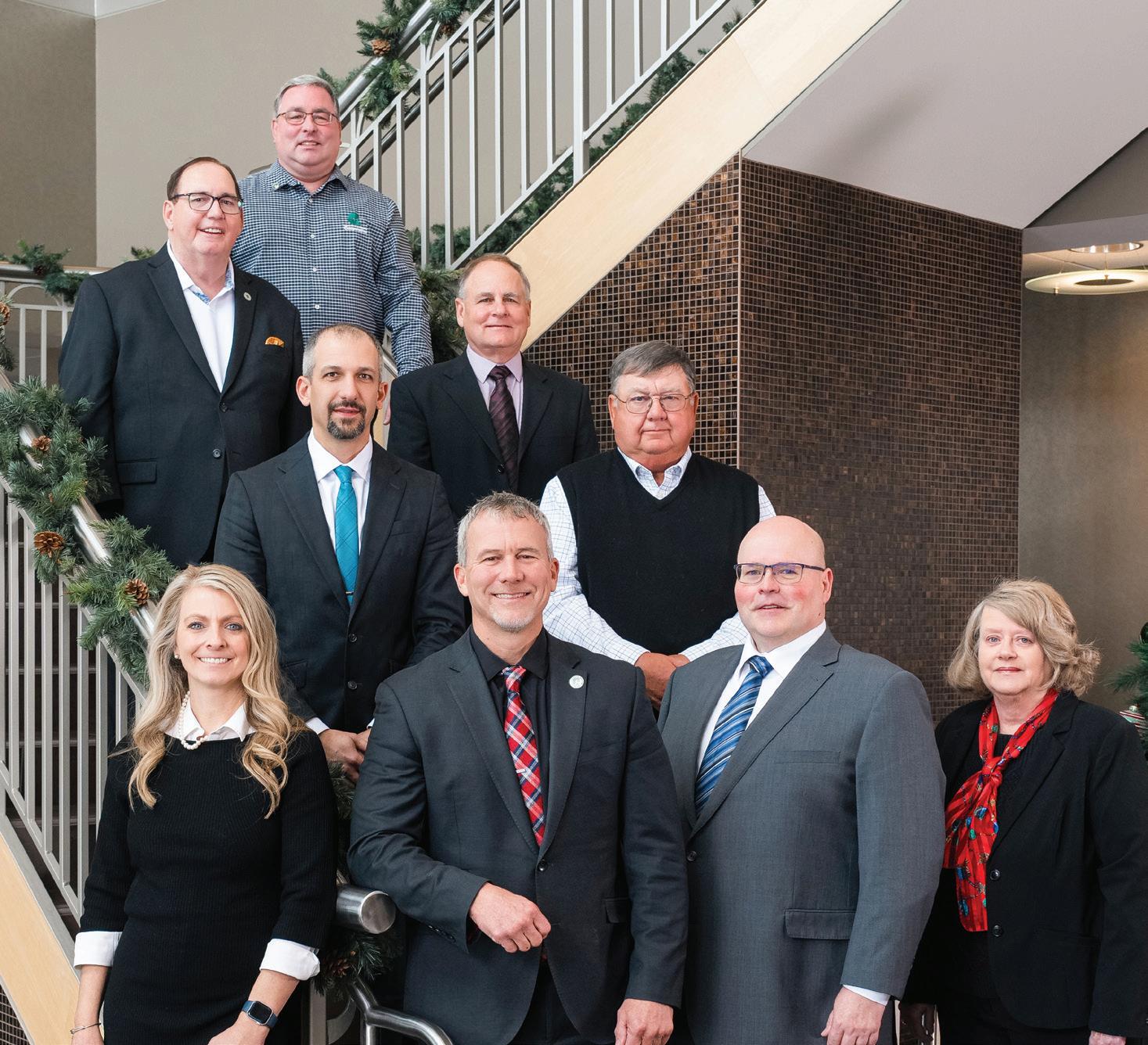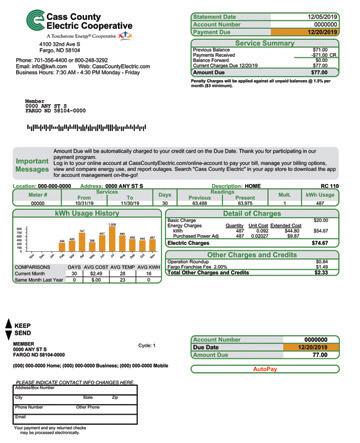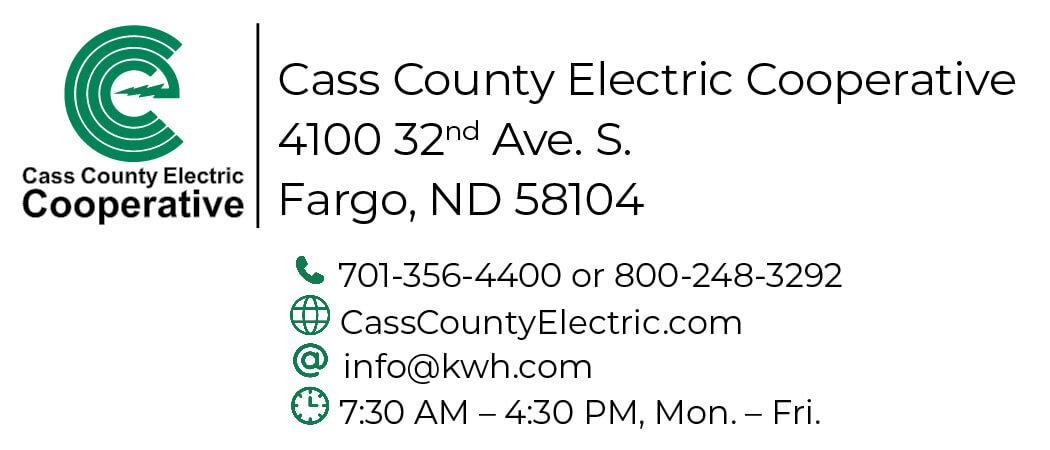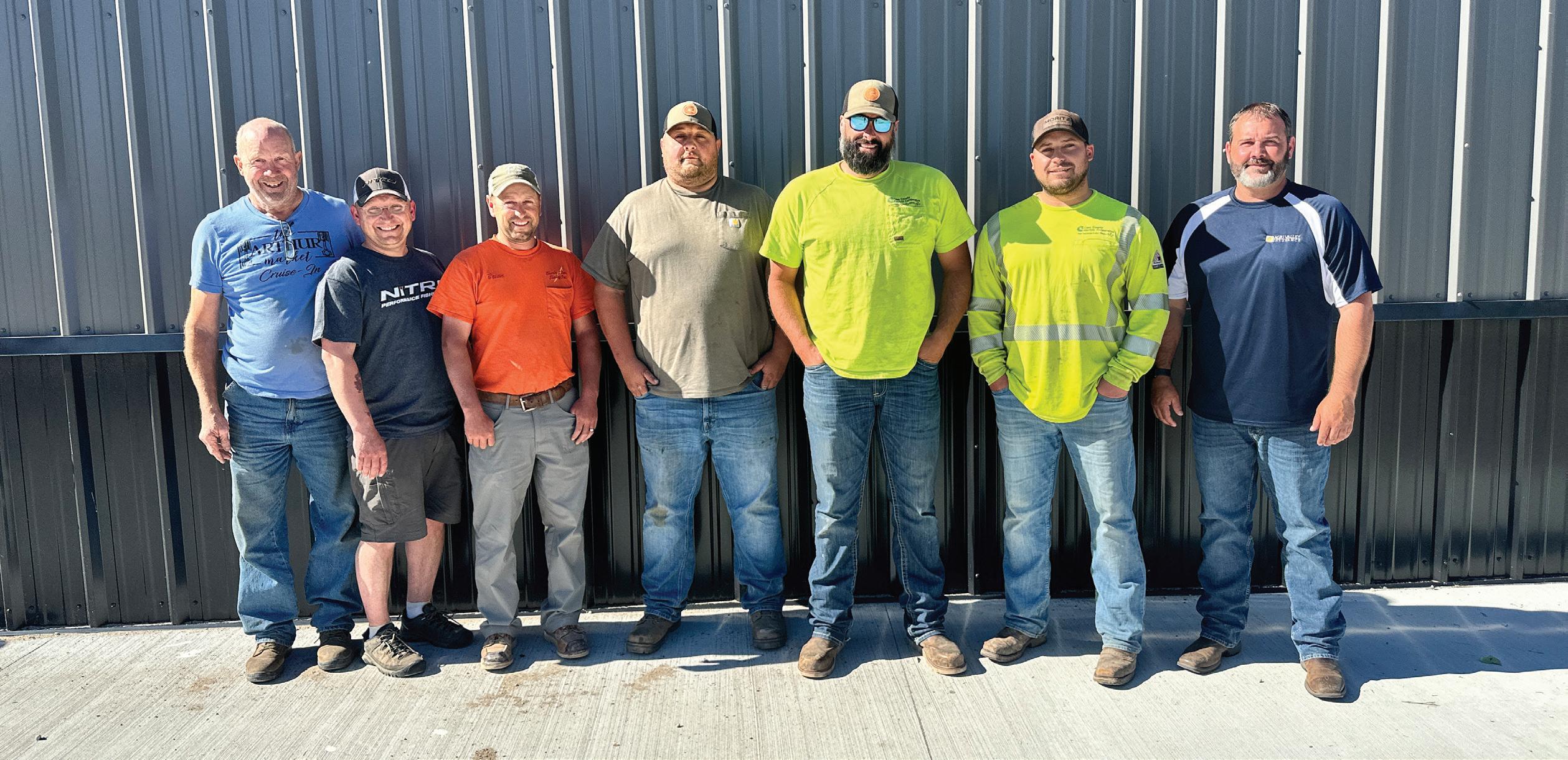March 2025

$2.75million PAGE 7
CAPITAL CREDIT RETIREMENT

March 2025

$2.75million PAGE 7
CAPITAL CREDIT RETIREMENT

When it comes to the energy supply and delivery business, nothing is for sure except uncertainty. Imagine being the head coach of a football team with excellent players, the brightest coaching staff, and the best fans anyone could ask for. Now, that seems like a great position to be in, but imagine trying to coach the team, execute your mission, and ultimately win a championship when the rules of the game change while you are still playing. Working in the energy business sometimes feels exactly like this, especially when administrations change, and a new vision is born.
A change in our administration has shed some positive light on our industry with the President’s
pro-energy agenda. We will continue to evaluate and share with our members the positive impact this will have in the days and months to come. We will also continue to work with our local, state, and federal elected officials to foster energy-friendly policies that strengthen our grid reliability, keep electricity rates stable, and maintain our environmental stewardship.
Cass County Electric is one of eleven distribution cooperatives that purchase power from Minnkota Power Cooperative. The eleven cooperatives work closely with Minnkota, helping shape the future of our power supply and distribution systems. One Board member from each distribution cooperative makes up the Minnkota Board, which meets monthly to discuss cooperative business, including power supply planning. Minnkota also has a Manager’s Advisory Committee (MAC), which meets at least ten times yearly to assist in this planning process. Cooperation among cooperatives is one of our seven cooperative principles and helps make us a successful and strong organization.
Carbon capture and sequestration, simple-cycle natural gas, cofiring natural gas and coal, zero emissions coal-fired plants, small
nuclear reactors (SMRs), more wind, and solar are all options the Minnkota team is looking at for future power supply resources. Each has its own set of challenges and opportunities. Rest assured, we look at every option with reliability and affordability and future cooperative generations at the forefront of our planning.
Minnkota recently announced the addition of a 370-megawatt (MW) wind farm near New Rockford, North Dakota. This project will help stabilize our purchase power agreement pricing (for wind) and secure long-term wind resources. They continue to evaluate the need for carbon capture and sequestration through Project Tundra while studying other options for future baseload power supply resources. Baseload resources (i.e., coal, nuclear, and natural gas) are vital to grid reliability and stability.
The energy industry will always have challenges and hills to climb. Still, we have a bright future with many exciting opportunities to lead the world in manufacturing, AI data storage, carbon capture, grid stability, and affordable energy prices. We must preserve our baseload resources to achieve these goals while maintaining a balanced power supply portfolio.
The Cass County Electric board of directors met in person on Jan. 31, 2025, and discussed the following topics:
• Approval of the January 2025 consent agenda for the regular board meeting, consisting of minutes, monthly department reports, director expense reports, and the December purchased power adjustment (PPA).
• Received the chairman’s report.
• President/CEO Paul Matthys gave the president’s report, providing updates from meetings and conferences attended.
• Received the 2024 year-end financial report.
• Moved to approve the payout of $2.75 million in capital credits, including estate capital credits, early retirement of capital credits less than $1,000, and capital credits for 2004 and 2005 (partial).
• Moved to approve the transfer of 2024 non-operating margins to the unallocated reserve account.
• Received the 2024 safety report and 2025 safety training plans.
• Received an update from the communications team.
• Received a report from the Minnkota Power Cooperative board meeting.
• Moved to approve the credentialing committee report.
• Moved to approve the January 2025 capital credit estate payments.
• Approved the Operation Round Up program audit procedures with Eide Bailly, LLP.
• Reviewed upcoming meetings and events.
The next board meeting is scheduled for Tuesday, March 25, 2025.


Communications:
Morgan Bachelor
Jocelyn Lura Hovland
Printer:
Forum Communications Printing
Board of Directors: Paul White, Secretary Douglas Anderson
Vanessa Kummer
Stacey Ackerman
Tom Seymour
Glenn Mitzel, Board Chair
Wendy Loucks
Kalvin Hoff, Treasurer
Terry Kraft, Vice Chair
Executive Staff:
Paul Matthys, President/CEO
Jodi Bullinger, VP of Engineering & Operations
Chad Brousseau, VP of Member & Energy Services
Chad Sapa, VP of Corporate Services & CFO
Tim Sanden, VP of Information Technology & CIO
Highline Notes (USPS 244-740) is published monthly by Cass County Electric Cooperative Inc., 3312 42nd St. S., Suite 200, Fargo, ND 58104. Periodicals postage paid at Fargo, North Dakota 58104, and at additional mailing offices.
Postmaster: Send address changes to Highline Notes 3312 42nd St. S., Suite 200 Fargo, ND 58104
Cass County
Cooperative 2025. All rights reserved.
These candidates will be up for election at this year’s annual meeting on April 15.

Marcy Svenningsen: Valley City, N.D.
Former director: 2012 - 2022
In 2022, in order to accept an appointment as the ND Farm Service Agency Executive Director, I had to step down from serving on the CCEC board. It has been my honor and privilege to work for our state’s farmers and ranchers the past three years. Now that my appointment has ended, I would welcome the opportunity to serve the members of Cass County Electric again. I believe I have the experience and skills that will allow me to be an asset on the board and a strong voice for the membership. I humbly ask for your vote and support.

Paul White: District 1, Stirum, N.D.
Incumbent: 2022 - Present
I have thoroughly enjoyed serving on the CCEC board over the past few years and remain committed to contributing to the continued growth and success of this cooperative. CCEC's diverse membership is something I deeply value and take pride in representing. My agricultural background, combined with my experience in manufacturing, gives me a unique perspective and strong drive to serve as a director. I am passionate about ensuring the cooperative thrives while meeting the evolving needs of its members.

Glenn D. Mitzel, Board Chair: District 6, West Fargo, N.D.
Incumbent: 2013 - Present
Safe. Affordable. Reliable. Those three ideals are the foundations of the cooperative. They are the basis of my decisions as a member of the board. And they will continue to be my basis in an ever-changing world and constantly evolving electric industry. I thank the members of CCEC for the privilege of serving on the board and look forward to the opportunity to continue to serve.

Kalvin Hoff, Treasurer: District 8, Fargo, N.D.
Incumbent: 2019 - Present
I am eager to continue my service to the CCEC Board of Directors to contribute to the continued success and evolution of an industry that is constantly changing. With my engineering background, I am well-equipped to evaluate and address future power supply challenges. I am passionate about serving a community-oriented cooperative and am committed to ensuring the future availability of reliable, affordable power for all members.

Cass County Electric Cooperative board members are elected to three-year terms each spring. To serve as a director, candidates must be members of the cooperative and reside in the director district they wish to represent. This means you, as a member, have the power to influence Cass County Electric’s operations by voting for your board representatives.
Democratic member control is a core principle that sets cooperatives apart from other businesses and utilities.
Check the back page of this magazine for details about the 2025 annual meeting.
At Cass County Electric Cooperative, we’ve always valued member participation in selecting our board of directors at the annual meeting. For those unable to attend in person, absentee voting is now an option!
Requesting your absentee ballot is easy:
• Visit us: 4100 32nd Ave. S., Fargo, ND 58104
• Call us: 800-248-3292 or 701-356-4400
• Email us: info@kwh.com
• Use our online form: CassCountyElectric.com/ contact-us
Important Details:
• Voting is open for Districts 1, 6, and 8.
• Ballots must be returned to Vogel Law by noon on Friday, April 11, 2025.
Your voice matters! Be sure to cast your vote!

DISTRICT 1

DISTRICT 6

DISTRICT 8
INVESTOR-OWNED
Privately owned by shareholders/ investors
Operate for a profit
MUNICIPAL SYSTEMS Owned by cities, counties, or states Not-for-profit
COOPERATIVE Owned and operated by the people they serve Not-for-profit
When you sign up for service with Cass County Electric Cooperative, you become a COOPERATIVE member.
BASIC CHARGE
Monthly charge that covers the cost to provide electrical service (infrastructure)
Included in capital credit allocation
FRANCHISE FEES
Fee charged by the cities of Valley City, Fargo, Horace, and West Fargo
$
ENERGY CHARGE
Charges for energy consumed during the billing period
Included in capital credit allocation
PURCHASED POWER ADJUSTMENT
A variable component calculated from the cooperative’s monthly wholesale power cost
1
Cass County Electric tracks how much electricity you buy and how much money you pay for it throughout the year.

Not included in capital credit allocation CREDIT ON BILL: Members with an active account CHECKS ISSUED: Inactive, former members A minimum
2 We pay the bills for things like power generation, maintenance, and new construction.
3
Then, at the end of the fiscal year, the cooperative determines if there are excess revenues, called margins.
03/15/25
4
Next, the cooperative allocates those margins to members as capital credits based upon their electric bill.
Included in capital credit allocation
5
Lastly, your board of directors decides to retire, or pay, the capital credits when our financial condition permits.
$2 .75 million
The Cass County Electric board of directors has approved the retirement of capital credits for the years 2004 and 2005 (partial) as well as estate and early retirement payments.
Search our list of unclaimed capital credits at CassCountyElectric.com/capital-credits to see if anyone you know is owed money from Cass County Electric Cooperative!

Your board of directors just approved $2.75 million in capital credit retirements!
Cass County Electric Cooperative (CCEC) is excited to announce that it will be returning $2.75 million in capital credits to its members who paid for electricity in 2004 and 2005 (partial). CCEC’s board of directors approved the retirement at its January 2025 meeting.
Cass County Electric Cooperative is a not-for-profit organization, meaning we operate at cost, and any excess revenues, or margins, are returned to our members in the form of capital credits. Since our inception, Cass County Electric Cooperative has retired more than $44 million.
Active consumer-members:
Capital credits will be applied in March, but reflected on your February billing statement.
Notification of the retirement is on your billing statement.
Inactive consumer-members:
CCEC encourages all members to view the capital credit retirement list on our website to see if they have friends or family with capital credits waiting for them.
It is important for all prior CCEC members to keep their contact and addresss information up to date so that we can ensure the receipt of later capital credit retirements.
How does the capital credit process work?
1. CCEC keeps track of how much electricity you buy and how much money you pay for it throughout the year.
2. At the end of the year, the cooperative completes financial matters and determines whether there are excess revenues, called margins.
3. Consumer-members receive a portion of the margins as capital credits based upon the amount of revenue each member contributed throughout the year.
4. When CCEC’s financial condition permits, your board of directors decides to retire (pay) the capital credit allocations from previous years.
5. The cooperative notifies you of how and when you’ll receive capital credit retirements on your billing statement.
If you’re like most people, you probably glance at your energy bill just long enough to see the total amount before paying it and moving on with your day. But have you ever stopped to consider what all those itemized charges mean?
Taking a closer look at your bill can be surprisingly beneficial. Not only can you track how much electricity you use each month, but you can also better understand how charges are calculated and spot usage patterns. This knowledge is especially helpful if you’re trying to conserve energy or reduce your monthly expenses.
To help you get familiar with your bill, here’s a guide to the key sections you’ll find each month:
Statement Date:
Found in the upper-right corner, the statement date indicates the billing period—typically a 30-day cycle for electricity you’ve already used.
Account Number:
Your account number, also in the top-right corner, is essential for managing your account. Use it to sign up for an online account or download the Cass County Electric mobile app. The app offers features like account management and detailed energy usage analytics to help you stay on top of your energy consumption.
Important Messages:
This section includes updates from Cass County Electric, useful tips, and any important announcements related to your bill or services.
Service Information:
Here, you’ll find your service address, rate class (RC), and the dates of service being billed. This section also displays your meter readings, which are key to determining your energy usage for the month.

kWh Usage History:
One of the most insightful parts of your bill, this section provides a visual chart of your energy usage over the past year. It highlights fluctuations—such as higher usage during extreme weather months—and includes details like the number of billing days, average costs, temperatures, and total kilowatt-hours (kWh) used.
Details of Charges:
Basic Charge: A fixed monthly charge that helps cover the cooperative’s costs to provide service.
Energy Charges:
kWh Charge:
The cost of electricity you used, calculated by multiplying your rate (cost per kilowatt-hour) by your usage (total kWh).
Power Adjustment:
Reflects variable costs in wholesale power.
This section captures additional charges and credits, including:
Monthly donations to the Operation Round Up program (typically less than $6 per year).
Franchise Fees imposed by cities,
collected by the cooperative, and dispersed to municipalities. These fees often help cities cover the costs associated with allowing utilities to use city rights-of-way for infrastructure.
Miscellaneous items such as renewable energy credits, demand waivers, connection or disconnection fees, or deposits.
Remittance Slip:
If you’re paying by mail, include the bottom portion of your bill with your payment. Keeping your contact information up to date ensures you receive outage alerts and account notifications. For more convenience, use the Cass County Electric mobile app to manage settings, set usage alerts, report outages, and adjust billing preferences.
Understanding your bill isn’t just about seeing where your money goes—it’s about empowering yourself to make smarter energy choices. With tools like usage charts, account management options, and detailed breakdowns, your bill can be an invaluable resource for tracking and optimizing your energy consumption.





A power surge is a sudden spike in electrical voltage that can damage electronics, appliances, and even start electrical fires. While lightning strikes are often blamed, most surges come from everyday appliances like air conditioners and refrigerators drawing power, as well as faulty wiring or overloaded circuits. These surges, whether minor or severe, can gradually wear down or instantly damage your devices.
To protect your home, use surge protector strips or upgrade to uninterruptable power supply (UPS) devices with battery backup for sensitive electronics. For broader coverage, consider installing a whole-house surge protector through a qualified electrician, and update outlets to include ground fault circuit interrupters (GFCIs) for added safety. Pair whole-house protectors with plugin surge strips for two layers of defense.
In 2024, the Arthur Rural Fire Protection District was granted
$1,000

to help complete their new fire hall.
The cooperative business model, rooted in community and focused on people, has a long history of building from the ground up. Cooperatives are owned and controlled by the people they serve, working together to meet shared economic, social, and cultural needs. Cooperatives are also committed to the communities they serve and work to help them prosper.
Since 1990, North Dakota’s electric and broadband cooperatives, in collaboration with their statewide trade associations, have championed a shared rural development services center to empower rural communities and sustain essential services that enhance the quality of life for our members. Together, we connect resources to needs and solutions to challenges.
The Rural Development Finance Corporation (RDFC) is a tool for implementing a collective vision for stronger, more vibrant rural communities. Through revolving
loan and grant programs, RDFC supports initiatives that foster economic diversification, including forming and growing cooperatives, small businesses, and non-profits.
The RDFC currently manages a multi-million revolving loan fund geared to help North Dakota communities of 10,000 or less. Additionally, the RDFC is in its second year of administering a $10 million meat processing load fund that will encompass the entire food chain as initial funds revolve. In 2024, rising construction costs and higher commercial interest rates sparked demand for more loan requests for more significant amounts.
development services
• Guide organizational and business development
• Provide business development analysis
• Develop and promote cooperative development strategies
• Assist in obtaining startup funds for research and development activities
• Provide start-up administrative services
• Provide professional referrals
• Coordinate local and statewide rural development efforts
Imagine the impact you could have on your community with the right support and resources. CCEC and NDAREC’s rural development service center assist with economic and community development projects, enhancing access to health care, childcare, food processing, housing, and infrastructure.
Our teams specialize in linking local, state, and federal funding sources to meet community needs. Whether your focus is on economic development or local projects, we provide expertise and technical support to bring your vision to life.
By partnering with CCEC and NDAREC, you can drive meaningful initiatives that improve quality of life and strengthen community pride. Together, we create a lasting legacy of progress and prosperity.

Motion sensor lights are a convenient lighting solution that automatically turn on when they detect movement, such as a person walking by or a car pulling into the driveway. Commonly used outdoors for security purposes, they’re also a practical option for indoor lighting.
With their growing popularity, many wonder if motion sensor lights are truly worth the investment. Let’s explore their benefits and drawbacks to help you decide.
One of the main reasons homeowners opt for motion sensor lights is to cut down on electricity usage. These lights only activate when needed, meaning you’re not wasting energy keeping them on unnecessarily. Over time, this can lead to noticeable savings on your energy bill.
By using less electricity, motion sensor lights help reduce your carbon footprint. If you’re looking for small ways to live a more environmentally conscious lifestyle, installing motion sensor lights can be a simple yet impactful choice.
Motion sensor lights can deter potential intruders by illuminating dark areas whenever movement is detected. This unexpected light can make burglars think twice about targeting your home or business, offering you an extra layer of protection.
One downside of motion sensor lights is that they can sometimes be triggered by non-threatening movements, such as wind-blown branches, passing animals, or even heavy rain. These false activations can be inconvenient, especially if they disturb your peace or waste energy.
Another common complaint is that motion sensor lights don’t always turn off as intended. For instance, a light might stay on longer than necessary or reactivate repeatedly due to nearby activity. This can be frustrating, particularly if it disrupts your sleep or other routines.
Light pollution
While motion sensor lights use less energy than traditional lights, they can still contribute to light
pollution—excessive or misdirected artificial light that impacts the environment. Bright outdoor lights, especially in urban or suburban areas, can obscure views of the night sky, disrupt wildlife behavior, and negatively affect human health by interfering with natural sleep patterns. To minimize light pollution, it’s important to position motion sensor lights thoughtfully and use bulbs that produce warmer, less glaring light.
Deciding whether motion sensor lights are a worthwhile addition to your home depends on your needs and preferences. If you’re looking to save energy, reduce costs, and enhance security, they can be a smart choice. However, if you prefer a lighting solution that stays consistently on or off, traditional lighting options might be more suitable.
Ultimately, motion sensor lights are a practical and eco-friendly option for many households, but understanding their limitations will help you determine if they’re the right fit for your space.
Check out our Pinterest page for more recipes!

tortellini soup
Ingredients
1 pound skinless chicken breasts
2 stalks celery, chopped
2 sprigs thyme
6 cups chicken broth
1 teaspoon Italian seasoning
Slow cookers transform simple ingredients into warm, hearty soups that are perfect for savoring during the final chilly days of winter. These recipes offer a comforting embrace with every spoonful, blending rich flavors and effortless preparation.

2 carrots, peeled and cut into coins
1/4 teaspoon crushed red pepper flakes
Ingredients
12 pieces bacon
2 pounds Yukon Gold potatoes, peeled and cubed
4 cups chicken broth
2 teaspoon fresh thyme leaves
Salt and pepper
1 1/2 cups milk
1/4 cup all-purpose flour
1/2 cup heavy cream
1/2 cup sour cream
1 1/2 cups shredded cheddar, plus more for serving
Optional: Chives, shredded cheese
Preparation
In a large skillet over medium heat, cook bacon until crispy, 8 minutes. Drain on a paper towel-lined plate. Once cool, crumble into pieces. In a slow cooker, combine potatoes, bacon, chicken broth, and thyme. Season with salt and pepper. Cover and cook until potatoes are tender, 4 to 6 hours on low or 2 to 3 hours on high. With a slotted spoon, remove half the potatoes from the slow cooker. Mash the rest in the slow cooker with a potato masher, then return the reserved potatoes. In a bowl, whisk milk and flour. Add milk, heavy cream, sour cream, and cheese to the slow cooker. Cover and cook on high for 30 minutes or until the cheese is melted and everything is warmed through. Serve with shredded cheese and chives.
Salt and pepper
18 ounces refrigerated cheese tortellini
Preparation
In a slow cooker, combine chicken, carrots, celery, and thyme. Pour in broth and season with Italian seasoning, red pepper flakes, salt, and pepper. Cook on low for 6 hours. Transfer chicken to a plate and shred with two forks. Return to slow cooker and add tortellini. Cook until tortellini are tender, about 15 minutes.
Ingredients
1 1/2 lb. beef chuck, cut into 2" pieces
Salt and pepper
Extra-virgin olive oil
3 cloves garlic, minced
1 onion, diced
2 carrots, cut into half-moons
2 teaspoons fresh thyme leaves
8 ounces cremini mushrooms, cut into 1/4" slices
1/4 cup pearled barley
1 quart chicken stock
1 Tablespoon soy sauce
Preparation
In a large mixing bowl, pat beef dry with paper towels. Season generously with salt and pepper. Preheat a large cast-iron skillet over high heat. Drizzle with olive oil and sear meat on all sides until golden brown with a crust, 8 to 10 minutes. Transfer meat to the slow cooker. Reduce heat to medium, add garlic, onions, carrots, and thyme, and season with salt and pepper. Scrape the pan with a wooden spoon to loosen all browned meat bits and cook for 3 to 4 minutes. If needed, add a splash of water to fully deglaze the pan; transfer to slow cooker. Add mushrooms, barley, stock, and soy sauce; cook on low for 8 hours. The meat should be very tender.

Installing a heat pump could be one of the best financial decisions for heating and cooling your home. Heat pumps use outdoor temperatures to provide heating and cooling at a fraction of the cost of conventional systems.
An air-source heat pump includes a compressor and two coils—one indoors and one outdoors. In winter, the outdoor coil absorbs heat, which is released indoors to efficiently maintain comfortable temperatures, even in extreme weather (-13°F to 90°F).
If you already own an AC unit, you might wonder if upgrading to a heat pump is worth it. The answer is yes, and here’s why.
Unlike traditional air conditioners that rely solely on electricity to create cooling energy, heat pumps move heat using outside energy. This process is much more energyefficient, resulting in significant savings. Heat pumps also match or exceed air conditioners in cooling efficiency, measured by the Seasonal Energy Efficiency Ratio (SEER). The Department of Energy reports that switching to a heat pump can save the average homeowner between $300 and $1,500 annually on heating and
cooling costs.
Today’s heat pumps are more effective than ever, thanks to advancements in technology. Modern systems are designed to operate efficiently in colder climates, with some models capable of providing reliable heat even when outdoor temperatures drop as low as -20°F. This improvement allows homeowners in colder regions to enjoy the benefits of heat pumps year-round. These advancements make heat pumps a practical and costeffective solution for a wider range of climates.
In addition to energy savings, installing a heat pump comes with financial benefits through federal tax incentives. Eligible homeowners can claim a tax credit for the purchase and installation of qualifying air-source heat pumps. Visit EnergyStar. gov for detailed information on eligibility requirements and credit amounts. While Cass County Electric Cooperative (CCEC) does not manage these tax credits, we encourage you to consult with a qualified contractor and a tax professional for guidance.
One of the unique benefits of enrolling in CCEC's off-peak program is that we offer electricity rates at about half the standard rate during non-peak hours. Heat pumps are ideal for this program as they efficiently manage energy use, keeping your costs low without sacrificing comfort. Combined with CCEC energy credits and federal incentives, heat pumps are an excellent investment for long-term savings.
CCEC members can receive a $150 per ton rebate for installed systems, further reducing upfront costs. This program is particularly attractive to members without access to natural gas for their heating needs.
With federal incentives currently in place combined with CCEC’s off-peak rates and credits, there has never been a better time to upgrade to an air-source heat pump. These systems provide year-round comfort and significant energy savings. Contact our energy management team at energy@ kwh.com to learn more about how a heat pump can benefit your home and take the first step toward a more efficient future.
All ads must be 40 words or fewer and will be abbreviated following our guidelines. No real estate or commercial ads will be accepted. Ads are published for members at no charge as space permits on a first-received, first-printed basis. Ads are due by the 10th of the month prior to publication. Members may submit only one ad per issue. Editor reserves the right to edit or reject any ad. Email ads to: ccec@kwh.com
For sale:
Medium & large ALICE pack w/ one frame. OD green, like new, $100. 701388-1107
Two NFL Viking caps. One new in bag, $27. Second Viking, $21. 701-8660218
2003 Harley Davidson Fatboy (100 anni.), 13,000 mi, fuel injected, detachable windshield, screaming eagle pipes, lockable saddlebags, chrome swingarm, pics avail., $6,500. 701-361-2551
2003 GMC Yukon, white w/ gray stripping & interior, 121,000 miles by two owners, nine-passenger seating, rear seating not used, was wrapped & stored inside for protection, new tires & alignment. 701-866-5399
Two Milestar MS932 235/45R18 tires, 50% tread left, $50. 701-219-3815
40 small antique cars 1/24 to 1/43 scale, buy one or all. 701-200-1108
Harman Pinnacle chair lift, beige leather chair w/ track, excellent cond., $1,500. Pride Mobility Go Chair, battery operated, excellent cond., pics avail. $1,600. Professional photography equipment, Archival Matts for prints in various sizes. 612760-2211
Yardman snow blower, 7 hp 2-stage serviced by Scheels, paid $900 new, $450/OBO. 701-388-6254
Wanted:
Used wood lathe w/ chisels if possible.701-212-8200




